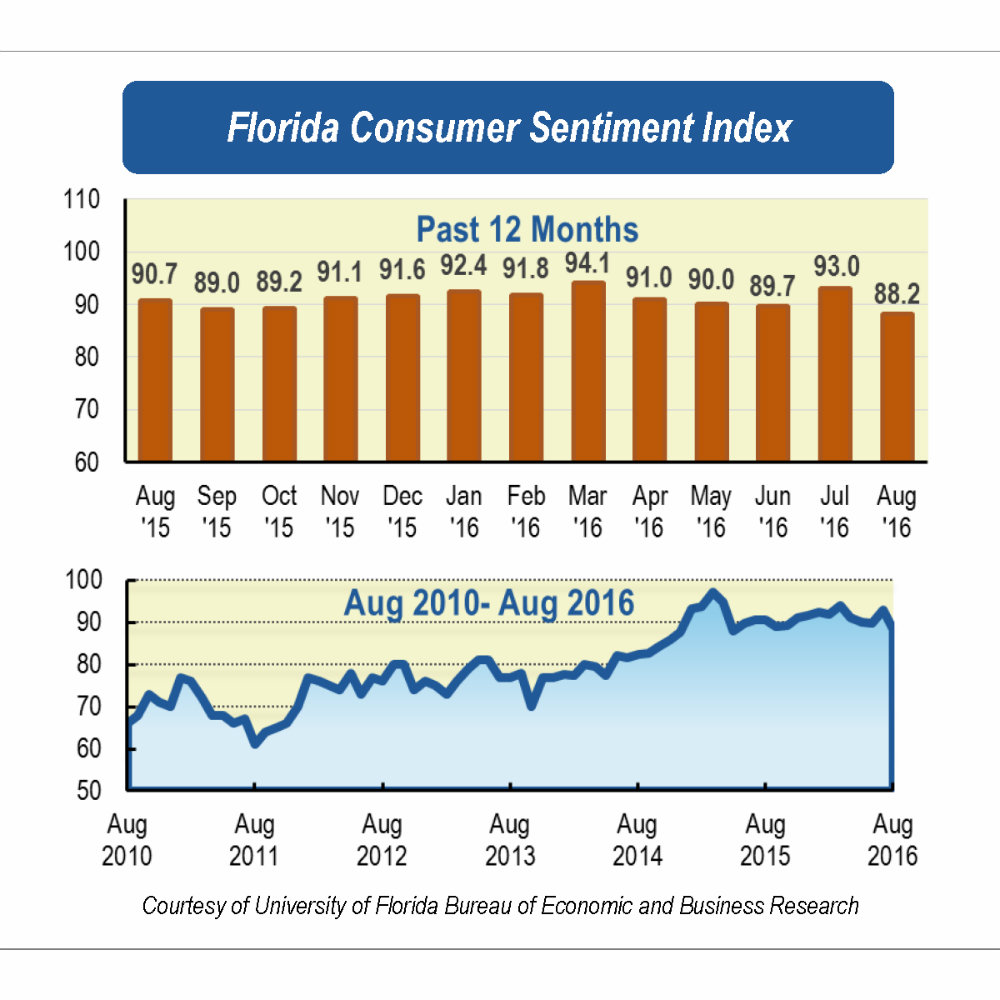
Consumer sentiment among Floridians plummeted 4.8 points in August to 88.2, according to the latest University of Florida consumer survey. This is the lowest reading in the last year, and all five components that make up the index declined.
Perceptions of one’s personal financial situation now compared with a year ago dropped most sharply, down 10.5 points from 86.7 to 76.2. Expectations of personal finances a year from now fell by 7.8 points to 98.6. Opinions as to whether now is a good time to buy a big-ticket item such as a car declined by 3.1 points from 101.9 to 98.8.
These downward readings were shared by all Floridians with the exception of those aged 60 and over, whose readings showed little change.
“Most of the pessimism in August stems from the perceptions of personal finance situation now compared with a year ago and the expectations of personal finance situation one year from now, as these two components account for more than three-quarters of the change in the index,” said Hector H. Sandoval, director of the Economic Analysis Program at UF’s Bureau of Economic and Business Research (BEBR).
Readings on U.S. economic conditions were down slightly for both short- and long-term expectations: dropping 1.9 points to 85.1 for conditions over the next year and down nine-tenths of a point to 82.1 for the next five years.
Five years ago in August 2011, as Florida was recovering from the Great Recession, consumer sentiment among Floridians was at its lowest level of 61.4 points. The effects of the recession were still felt in Florida, with high levels of unemployment at 9.6 percent, and negative state Gross Domestic Product (GDP) growth rates, a negative 2 percent in 2011.
Today, Florida’s consumer sentiment is 26.8 points higher, Florida GDP increased by 2.1 percent in the first quarter of 2016 and ranked 10th in the nation, slightly higher than the 1.9 percent growth rate for the U.S. Furthermore, the real GDP growth rate in Florida has remained positive since 2012. Unemployment levels in Florida are currently at their lowest since the last recession, with an unemployment rate of 4.7 percent, unchanged from the previous two months.
“Despite the positive economic signals, consumer sentiment among Floridians seems to remain gloomy,” Sandoval said. “Except for July’s reading, consumer sentiment has followed a slightly downward trajectory over the last six months.”
Sandoval said that the state’s job market may be having an influence. “Although the number of jobs added statewide has remained positive for an outstanding 72 consecutive months, the unemployment levels haven’t decreased for the past three months, suggesting that the labor market has reached its ‘natural’ unemployment level. It is possible that economic agents are expecting a downturn in the economic activity in the medium-run, which is reflected in the latest trends of the consumer sentiment index.”
Some of the biggest drops in August were among those with incomes of $50,000 and over, down 10.4 points on expectations of their personal financial situation in a year. This may be partially due to concerns over decisions regarding retirement savings like IRAs and 401ks, whether to move money out of the stock market over predictions of an upcoming correction after seven years of record increases.
“We should keep in mind that consumer sentiment is in part designed to predict consumer spending,” said Chris McCarty, BEBR director. “Like much of the rest of the country, retail sales in Florida have been boosted by auto sales which are supported by historically low interest rates. Taking auto sales out of the picture, consumer demand for goods and services has been tepid and inflation well below the target rate of 2 percent. This is one of the indicators that raises questions for Federal Reserve Board members when they consider whether to raise interest rates in their September meeting. Most economists do not expect a rate increase any time soon.”
Conducted Aug. 1-21, the UF study reflects the responses of 415 individuals who were reached on cellphones, representing a demographic cross-section of Florida.
The index used by UF researchers is benchmarked to 1966, which means a value of 100 represents the same level of confidence for that year. The lowest index possible is a 2, the highest is 150.
Details of this month’s survey can be found at http://www.bebr.ufl.edu/csi-data.